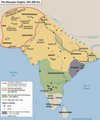దస్త్రం:Standard Mauryan Empire.png

ఈ మునుజూపు పరిమాణం: 499 × 599 పిక్సెళ్ళు. ఇతర రిజల్యూషన్లు: 200 × 240 పిక్సెళ్ళు | 400 × 480 పిక్సెళ్ళు | 640 × 768 పిక్సెళ్ళు | 853 × 1,024 పిక్సెళ్ళు | 1,706 × 2,048 పిక్సెళ్ళు | 3,054 × 3,666 పిక్సెళ్ళు.
అసలు దస్త్రం (3,054 × 3,666 పిక్సెళ్ళు, ఫైలు పరిమాణం: 1.21 MB, MIME రకం: image/png)
ఫైలు చరితం
తేదీ/సమయం ను నొక్కి ఆ సమయాన ఫైలు ఎలా ఉండేదో చూడవచ్చు.
| తేదీ/సమయం | నఖచిత్రం | కొలతలు | వాడుకరి | వ్యాఖ్య | |
|---|---|---|---|---|---|
| ప్రస్తుత | 05:35, 9 ఫిబ్రవరి 2024 |  | 3,054 × 3,666 (1.21 MB) | Buddhamitra sangha | More clarification |
| 22:37, 7 ఫిబ్రవరి 2024 |  | 3,054 × 3,666 (1.21 MB) | Buddhamitra sangha | Quality | |
| 22:10, 7 ఫిబ్రవరి 2024 |  | 3,054 × 3,666 (695 KB) | Buddhamitra sangha | Ceded area correction | |
| 04:50, 8 డిసెంబరు 2023 |  | 3,054 × 3,666 (1.43 MB) | Buddhamitra sangha | Uploaded own work with UploadWizard |
లింకులు
కింది పేజీలలో ఈ ఫైలుకు లింకులు ఉన్నాయి:
సార్వత్రిక ఫైలు వాడుక
ఈ దస్త్రాన్ని ఈ క్రింది ఇతర వికీలు ఉపయోగిస్తున్నాయి:
- ba.wikipedia.org లో వాడుక
- ca.wikipedia.org లో వాడుక
- hi.wikipedia.org లో వాడుక
- hu.wikipedia.org లో వాడుక
- nl.wikipedia.org లో వాడుక
- wuu.wikipedia.org లో వాడుక
- zh.wikipedia.org లో వాడుక